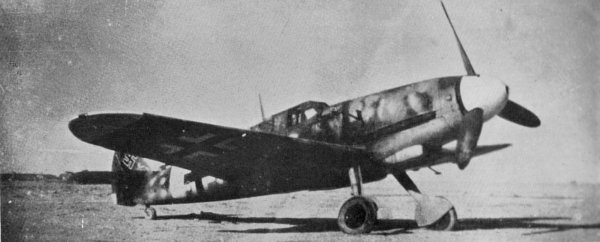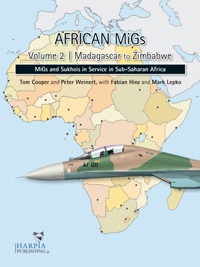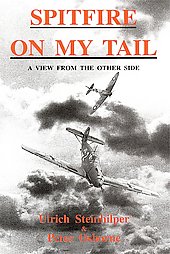It is again the second world war, which yields a very good book. This time it’s a book by a German Messerschmitt 109-pilot who was shot down on October 27, 1940 by a Spitfire over the south east of the United Kingdom. The Battle of Britain was in full swing and not long after that date Germany would decide to stop attacking the UK and to retreat her ‘Jagdgeschwader’ of which Steinhilper was part of.
The book is written by Ulrich Steinhilper and Peter Osborne. Peter Osborne is an Englishman who had to end his career with the London Fire Brigade prematurely. After leaving the Fire Brigade he and Ulrich Steinhilper wrote this unique book. I would like to call the book a unique one because a) there are much less German books than English books written about the Battle of Britain and b) because it is handwritten from first hand and very detailed.
The book is 350 pages thick and includes a series of personal letters to family members and 80 black and white photographs, most of which are taken by Ulrich Steinhilper
himselves. He had a fascination for photography and filming. The book is written in the first person and that makes it easy to empathize with that time.
After the introduction the book starts with a chapter that describes what happened in the last mission in which Ulrich Steinhilper was shot down. It was the last of one of his 150 combat missions over the North Sea and is an impressive story of a mission that unfortunately –for Steinhilper!-went wrong. During his 150 missions he became one of the many German ‘Aces’. After the first chapter the book starts with the story of Ulrich Steinhilper. He explains in detail how he grew up in a middle-class family in the midst of a Germany under Hitler that was recovering from the trauma of World War I and also was preparing for another war: a war that had to provide more ‘Lebensraum’ for the Germans and thus, could only mean that the borders of the German Empire had to be shifted and expanded.
Ulrich Steinhilper was more or less randomly appointed to communication officer and he tells what this was all about in an era that it was all very simple and spartan. Remarkably is that he describes how his superiors did not see the added value of communication equipment on board of the aircraft and thus did not support the developments in this area. Partly because many aircraft were not equipped with radio direction-finding equipment many accidents happened, and Steinhilper was a eyewitness of some. The communication between planes was very rudimentary and this put the Germans behind on the allied forces. Ulrich Steinhilper believes that this is one of the main factors which caused that the Germans finally lost the battle of Britain.
Whitin the ‘airy’ story are a lot of interesting details that reflect the ‘other side’. Where the outside world thought the German Army was one army, reality was a little more nuanced. There was certainly, at the beginning of the war, much rivalry as to which army unit was the best. In the late thirties the Luftwaffe was initially found to be inferior compared to other army units.
An eyo-opener was the fact that many pilots within the Luftwaffe had merely one goal and that was firing as many aircraft down for individual gain and glory. Steinhilper felt very disturbed of officers and in the eyes of Steinhilper Ace Galland –who was one of his chiefs- was very selfish. Adolf Galland was one of the ‘clique’ who had flown in the Spanish war, and thus before the outbreak of World War II had experience with fighter planes. This group of pilots were heroes in Germany and were an important part of the top of the Luftwaffe led by the vain Goering. It was particularly this group of pilots who thwarted the developments in the field of radio communications because all that was not found necessarily and that was the reason why Steinhilper regularly collided with his higher management. The tactics of the Germans was that the ‘Aces’ flew in the front of a group, the newcomers at the back. The latter was first shot by the Allies, so that the aces could go to raise their score. The Allies did not have these kind of tactic.
One detail that impressed me was that of a German pilot who, after dogfights over the channel, was barely able to reach the airport and after landing died instantly in his plane because he was hit by a bullet. Know that he was one of the approximately 200,000 “airmen” who were killed in World War II. Amazing amouts of deads. In 1939 the squadron of Steinhilper counted 36 pilots and all had at least 3 years experience. In October 1940 this group counted only four. Many of all the pilots who had a engine failure, defect or a deficiency of gasoline crashed, robbed themself of their life with their service pistol or drowned if they were not deadly crashed.
Ulrich Steinhilper flew his missions over the North Sea from the beginning of August 1939 to 27 October 1940 and was based on the Coquelles near Calais. These are approximately 80 days with conditions which were very primary and simple. Living this life combined with the stress, anxiety and fatigue caused by many pilots ‘Kanalkrankheit’. This ‘Sickness’ ensured that lots of pilots under the guise of ‘faults on the aircraft’ or ‘pain in their stomach’ left the battlefield early and returned to their base, to a hospital or even Germany. The book is fascinating and detailed! Ulrich Steinhilper comes across as a right-thinking, righteous man and nice guy who unfortunately worked for the other side. The only thing missing in the book is a land map of Germany, Belgium and the North Sea. That would make it easier to follow the movement of Steinhilper during his service.
When the writer was shot, he was captured and became a Prisoner of War (POW). He was transferred to Canada and the USA where he managed to escape several times. After the war, Ulrich Steinhilper was very successful for IBM in Germany. He wrote this book in addition to two other autobiographical books; ‘Ten Minutes To Buffalo’ and ‘Full Circle’. He died in 2009. Also check http://www.steinhilper.de/steinhilp/Ulrich/curri.html and http://www.acesofww2.com.











Leave a Reply